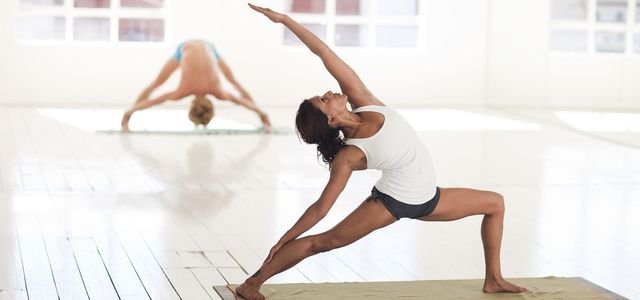
Power Yoga is all about one thing: Power! This modern yoga style is particularly sweaty and exhausting. We will explain to you what is behind Power Yoga and whether the style is suitable for you or not.
Ashtanga, Vinyasa, Jivamukti or Kundalini: Most yoga styles are named after Sanskrit and do not reveal much about the practice at first. It’s different with Power Yoga: The eponymous term “Power” means something like “Energy” or “Power” in German.
Power Yoga: Modern style with traditional roots

(Photo: CC0 / Pixabay / shushipu)
Power Yoga was invented in the 1990s by the American yoga teacher Bryan Kest. He had previously learned from traditional teachers in India, including from K. Patthabi Jois, the “founder” of Ashtanga yoga.
Kests yoga style based on the traditional Ashtanga yoga, which he changes decisively in two aspects:
- On the one hand, there should be no prescribed series in Power Yoga, but the lessons should be adapted and varied to the level of the students.
- On the other hand, he focuses on physical practice and eliminates practically all spiritual elements as well as meditation and breathing exercises.
In doing so, he makes yoga practice more accessible to western cultures, where yoga was still associated with esotericism for hippies by many. Since then, with Power Yoga, there has been a style that is known as Fitness workout trains the body. This is particularly popular in western America.
Bryan Kest himself emphasizes the importance of meditation and has holistic health and nutrition as well Vipassana meditation educated. He teaches that physical fitness and appearance eventually fade and that ultimately it comes down to the inner attitude in life. According to him, Power Yoga is supposed to be too inner peace and contribute to mental health.
Today Bryan Kest is a respected yoga teacher whose studio in Los Angeles is also visited by celebrities like Madonna and Drew Barrymore. Power Yoga has become popular beyond the USA and has found its way into yoga studios and fitness centers in Germany.
Characteristics of Power Yoga: Sweaty flows and powerful movements



(Photo: CC0 / Pixabay / jdj_land)
In a typical power yoga class, the strong influence of Ashtanga is Vinyasa yoga Clearly recognizable: The processes are mainly based on the asanas (postures) of the first series in the Ashtanga yoga. Unlike in its traditional form, the sequences in Power Yoga are not fixed, but are varied depending on the lesson and student: in.
Many asanas are practiced, which in addition to Ashtanga Yoga also come from the Hatha yoga are known:
- A power yoga class usually starts with several Sun salutationsthat warm up the body.
- This is followed by many well-known postures such as the dog (Adho Mukha Svanasana), the triangle (Trikonasana), the chair (Utkatasana) or the Crow (bakasana).
- These postures are usually fluidly linked: This practice is known as Vinyasa and makes Power Yoga one dynamic yoga stylewho keeps the pulse busy.
In addition, dynamic sequences and movements are built in, for example from looking down dog into the support posture and back again.
Little space for spirituality: The focus in Power Yoga



(Photo: CC0 / Pixabay / StockSnap)
It is not just the physically demanding practice that has given Power Yoga the reputation of a fitness workout: it differs from many other yoga styles neither meditation nor pranayama (Breathing exercises) Part of normal lessons. Not to mention spiritual practices such as chanting mantras or studying ancient Indian texts … That lies in Power Yoga Clear focus on physical exercise.
That’s why Power Yoga and its offshoots like Power Vinyasa Yoga and Power Core Yoga also find their way into gyms where there are no meditative or spiritual practices. Often such yoga styles are also offered as workouts or sports lessons.
There Power Yoga is not a protected term is, it is often used to describe and advertise very different offers. Especially in fitness clubs, sports are offered as power yoga, which have more in common with classic workouts or aerobics than with yoga.
Nevertheless, according to inventor Bryan Kest, regular power yoga should not only lead to a toned body, but also contribute to a calmer mind. Because even if there is no silent meditation, the exercises require plenty Mindfulness. So even a yoga class with a workout character can lead to inner peace.
Alternatives to Power Yoga
With its clear focus on physical exercises, Power Yoga and its offshoots are especially suitable for you if you have your own Keeping your body fit, building muscles, becoming more flexible or losing weight want. But you shouldn’t expect spirituality, breathing exercises or meditation. Since the power yoga lessons vary significantly depending on the studio and teacher, it is best to look at several offers and try them out.
Alternatives:
- If, on the other hand, you are looking for a holistic yoga style with meditative elements, you should Jivamukti Yoga and Ashtanga yoga look at.
- If all these styles are too strenuous for you, classic would be Hatha yoga something for you.
- Yin yoga on the other hand, is the right thing if you want to take it easy or are looking for a balance to power yoga.
- If the focus should be clearly on spiritual and meditative practice for you, you could Kundalini Yoga accept. It’s the opposite of power yoga, so to speak.
Would you like to integrate more mindfulness into your everyday life through yoga? Then listen to this episode of Utopia Podcasts, For example Spotify, Apple Podcasts, Google Podcasts or directly here:
Read more at Utopia:
- Yoga Dog: The downward looking and upward looking dog explained simply
- Niyamas: This is how the Yoga Code can help you in your private life
- Morning exercise: 8 reasons for a morning workout